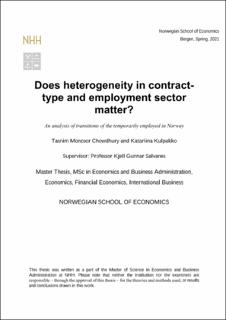Does heterogeneity in contract-type and employment sector matter? : an analysis of transitions of the temporarily employed in Norway
Master thesis
Permanent lenke
https://hdl.handle.net/11250/2772158Utgivelsesdato
2021Metadata
Vis full innførselSamlinger
- Master Thesis [4372]
Sammendrag
Over the past few decades, temporary contracts have become increasingly important in determining career trajectories of individuals. For some, it has worked as a bridge to permanent employment, while for others, it has led individuals to be stuck in a cycle of unemployment and temporary employment (Booth et al., 2002; Gash, 2008). A possible explanation for this is that temporary employees are a heterogenous group for whom temporary contracts vary from one individual to the other (Berglund et al., 2017; Fuller & Stecy-Hildebrandt, 2015; Rasmussen et al., 2019). Hence, with this thesis, we address this heterogeneity and study transitions of temporarily employed in Norway using data from the Norwegian Labour Force Survey between 2006 until 2018. Using linear probability model for our analysis, temporary employees are assessed as a heterogenous group whose probabilities of transitioning to permanent employment, unemployment and remaining in temporary employment differ within the group depending on the reason for temporary contract and sector of employment. Our findings depict that for temporary employees on probationary contract, the temporary employment contract acts as stepping stone into permanent employment. Furthermore, temporary employees in the public sector are less likely to transition to permanent employment and more likely to remain temporarily employed relative to the private sector after a little over two years and, hence, our results indicate that temporary employment is more persistent in the public sector. Furthermore, using data from Statistics Norway for years 2006-2020, we studied the impact of 2015 policy change, where the maximum length of a temporary contract was extended to 12 months in the private and municipality sector, on the use of temporary contracts in Norway. We found that, on aggregate level, the policy change had no effect on the use of temporary contracts in Norway. However, the effect on sub-groups differed as for interns, the policy change led to an increased use of temporary contracts, but seasonal work remained unchanged.
